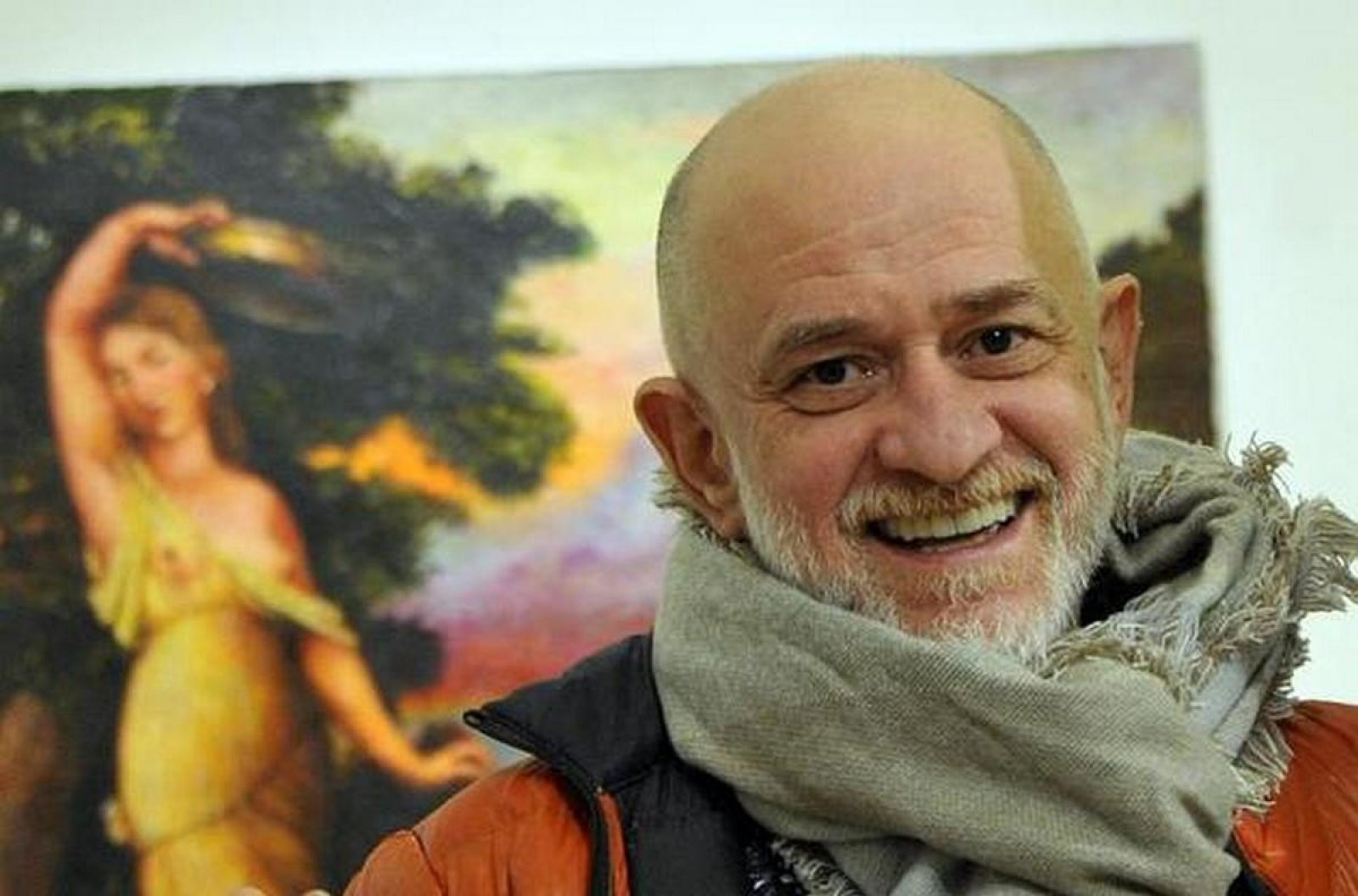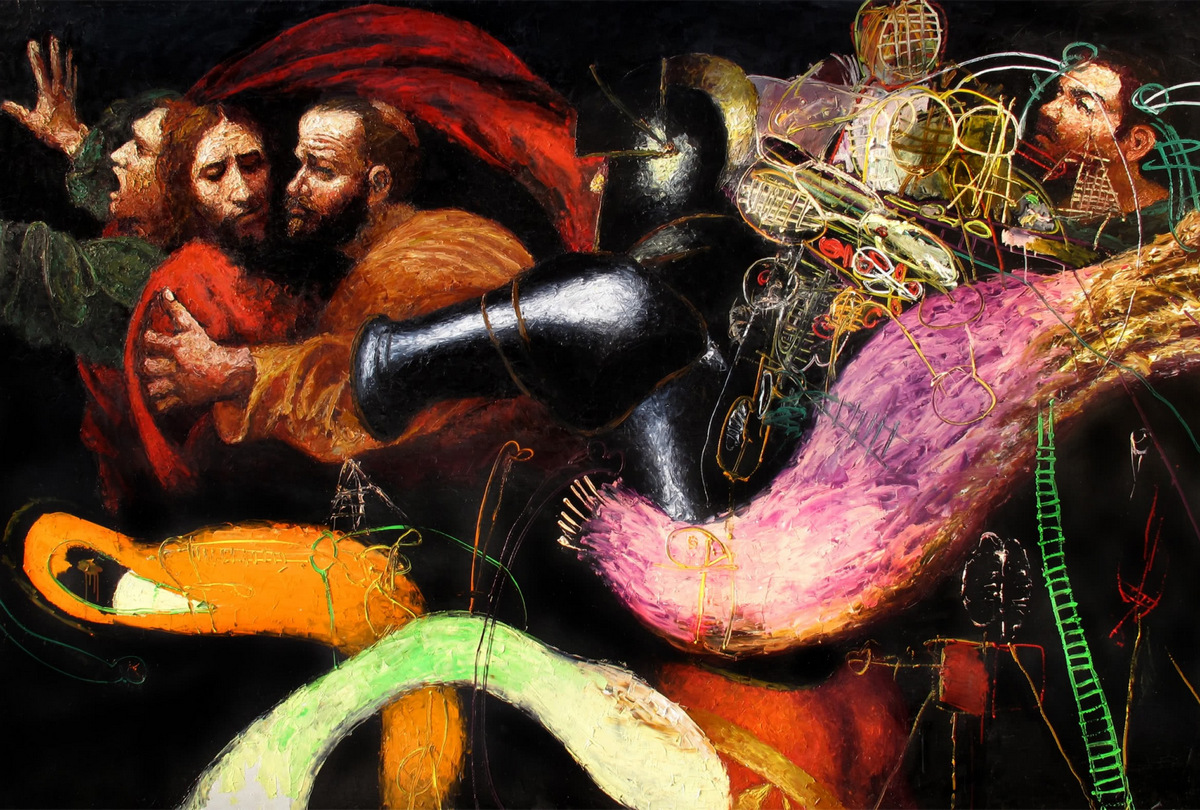

The future postmodernist artist was born in Odessa on October 14, 1961. His family had nothing to do with the world of art, so his father wanted his son to choose a career as an architect. Fortunately, this did not happen, and creative experiments in adolescence became a prelude to an eventful creative path. The desire for complete personal self-realization constantly pushed Roitburd to actively participate in public and political life.
The beginning of the creative path
The career of an architect did not attract Roitburd due to the lack of a creative component in this profession. The fact is that in the days of the USSR, mainly standard projects were built, so such an activity could only be called creative with a stretch. The desire for real self-realization leads Roitburd to the graphic arts department of the Odessa Pedagogical Institute, which he successfully graduated in 1983. The beginning of Perestroika opened up new perspectives for creativity: the Iron Curtain lets in more and more information about the outside world and the work of foreign masters. In an atmosphere of anticipation of the dawn, Alexander gets acquainted with the ideas of postmodernists, borrowing not only their style, but also their way of thinking. Soon, Roitburd's works appear at exhibitions in museums in Poland, Germany, France, the USA, Slovenia and other countries. The turning point in creativity was the Republican Youth Exhibition in 1987. On it, the artist presented his postmodern model of art, challenging the validity of the traditional hierarchy of values. Since then, the plots on the canvases have become provocative and scandalous, known to contemporaries.
Roitburd-artist
The artist devoted most of his career to the deconstruction of various symbols and images of traditional culture. In the best traditions of postmodernism, political figures, human figures and fantastic animals underwent transformations on canvas. This cup and self-portraits did not pass. On them, Roitburd demonstrated the consistency of his views and his willingness to ridicule even himself. The master's paintings are highly valued in the EU and the US: he holds the record among Ukrainian artists in terms of the number of auction sales (about 40). You can admire Roitburd's works in the museum MoMA in New York, Odessa Art Museum, PinchukArtCentre in Kyiv and Duke University Museum in Derham (USA). Throughout his life, the master used scandal and paradox as a means of drawing attention to topical issues. It is difficult even to count the exact number of stories ending with fierce criticism of creativity, accusations of immorality and lengthy proceedings. Roitburd's work often evokes mixed emotions. The beautiful here is combined with the ugly for the sake of ridiculing the confusion and paradox of modern life.
TOP most interesting works by Roitburd
The master loved to shock the audience, boldly playing with characters and meanings familiar to culture. Among his works you can find portraits, still lifes, landscapes and paintings of other genres, made in a characteristic author's manner.
"Farewell, Caravaggio"
The most famous work of the artist, widely known after the successful auction Phillips, where it was sold for 97.5 thousand dollars. According to the author, the price rose to this mark after several resales. The fee of Roitburd himself was much more modest.

"Goodbye Caravaggio" Alexander Roitburd. Photos © folga.com.ua
The history of its creation is also of interest: the painting was painted after the theft of Caravaggio's painting "The Kiss of Judas, or the Taking of Christ into Custody" from the Odessa Museum of Western and Oriental Art. By the way, works from home were also stolen from Roitburd himself. As the artist said, contrary to his custom, he once hung his favorite painting on the wall, and after returning from the USA, he was annoyed to find that it had been stolen.
"Cubist landscape with a church"
A very interesting urban landscape, in general terms reminiscent of the early experiments of the cubists with form. The master painted this picture while still studying at the institute in 1981. The canvas testifies to the acquaintance of its author with the tradition of the avant-garde back in the days of the Iron Curtain and the active search for his own style in the early years.
"Jean-Jacques Rousseau in primeval bliss"
The canvas somewhat contrasts in its content with other artworks of the artist. The portrait of the philosopher Rousseau surrounded by swans does not in the least ridicule or deconstruct his doctrine of the paradisiacal existence of man outside civilization. The calmness of the thinker surrounded by birds against the backdrop of slightly pinkish mountains is a clear confirmation of this.
Painting from the "Still life" series
Perhaps the most scandalous painting by the artist, which became one of the formal reasons for his dismissal from the post of head of the Odessa Art Museum in 2019. It depicts close-up sexual intercourse in warm colors. Representatives of the Opposition Platform for Life argued that such art destroys the moral foundations of society and was allegedly written with the help of excrement. In April 2019, the media reported that the master plans to sell the painting at auction.
"And Lenin is so young"
Another scandalous work dedicated to one of the founders of the USSR. On the canvas, against a dark green background, a half-naked leader of the world revolution in shorts appears before the viewer. The erotic connotation of the plot is undeniable. The artist was engaged in such deconstruction throughout his life. According to him, the Soviet ideology did not cause him much admiration, and the image of the leader himself was perceived as a symbol of the dictatorship that destroys the human personality. In 2016, he also proposed to leave the monument to Lenin in Zaporozhye, with a slight modernization. On Facebook photo collages, viewers saw various versions of the monument with animal heads.
"Skovorodina night on the Dnieper"
One of Roitburd's last works, written in 2021. The Ukrainian philosopher Hryhoriy Skovoroda is depicted in unusually bright colors for the master, surrounded by a mollusk, shrimp and jellyfish. In the background is the Dnieper in the light of a bright green moon. It is not known for certain what meaning the author put into that plot, but sometimes postmodern art plays with meanings for the sake of the game itself. The picture attracts attention with the brightness of images and color solutions unusual for the master.
Participation in politics and public life
Art is always included in the socio-political context of its era. Agreeing with this idea, Roitburd never denied himself the pleasure of using his works for annihilating criticism of stereotypes, illusions and vices. His brush belongs to a series of satirical portraits of famous figures in Jewish national clothes called « If there is no water in the faucet. The master's works ridicule everyday anti-Semitism, trying to build absurd conspiracy theories to explain the crisis in society.
In 2013-2014, Roitburd took an active part in the Revolution of Dignity. In his own words, the surrealistic pictures of the confrontation between the fiery revolutionaries and the Berkut soldiers, dressed in a modern version of the armor of Roman legionnaires, demonstrated the postmodern concept of the mixing of times better than any descriptions. He was also the curator of the "Code of Mezhyhirya" exhibition, which displayed valuable items that were in the residence of the fugitive president. After the events on the Maidan, the artist repeatedly declared his patriotic position and deep sympathy for Ukrainian culture. At the same time, he continued to use the Russian language in communication and spoke out in favor of preserving the territory of its use, free from Ukrainization.

Alexander Roitburd. Photos © kyivdaily.com.ua
He also owns the assertion that during the events of May 2, 2014, not a single inhabitant of Odessa was injured, for which he was later criticized by pro-Russian activists and politicians. In his interviews, the artist has repeatedly spoken about the situation on the Ukrainian art market. In his opinion, the main obstacle to the development of Ukrainian art is the position of the authorities. Representatives of business and the political elite are actively withdrawing capital abroad, not particularly thinking about finding opportunities for the development of the country. The influence of Roitburd on the socio-political processes in Ukraine has not yet received its final assessment. As a real artist, he saw phenomena and processes in all their ambiguity and did not seek to decorate everything in the desired colors and shades.
Recent years
In one of his interviews a few years before his death, Roitburd noted that with age he increasingly seeks solitude and rarely attends big parties. Without leaving his house for weeks, he actively participated in social and political life through social networks. In recent years, the master visited the capital only to meet friends and participate in exhibitions. The news of the death of one of the most prominent representatives of the South Ukrainian school of painting came as a real shock to the public. Until the last Roitburd to anyone did not talk about the serious illness that caused his sudden death on August 8, 2021. According to the Minister of Culture and Information Policy Alexander Tkachenko, it is planned to open a museum of contemporary art in Odessa in memory of Alexander Roitburd. It is also known about the initiative of the deputies of the EU party to rename one of the streets in Odessa in honor of a famous Ukrainian. In the full sense of the word, he was the son of his era, eclectically combining in his work the global desire to renew art with national specifics.
KyivGallery art critic
